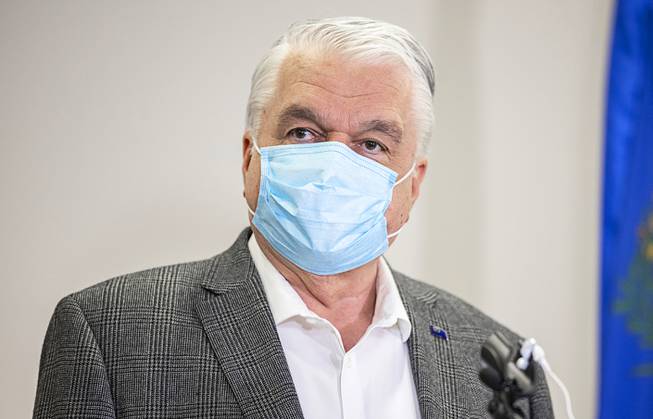
Benjamin Hager/Las Vegas Review-Journal/Pool
Gov. Steve Sisolak discusses Nevadas recent COVID-19 figures during a press conference at the Grant Sawyer State Office Building on Tuesday, Oct. 20, 2020, in Las Vegas.
Published Monday, Jan. 11, 2021 | 6:35 p.m.
Updated Monday, Jan. 11, 2021 | 8:30 p.m.
Nevada is coming up short when it comes to the COVID-19: It’s in the bottom 10 states for vaccine distribution, and the federal government’s allocation practices are behind it, state officials say.
What precisely they plan to do about it is, as yet, generally unclear.
Nevada ranks 44th in vaccines administered per 100,000 people and 42nd in vaccines distributed per capita, according to data released Monday by the Centers for Disease Control and Prevention. Making matters worse, federal custodians announce allocations a week at a time, which makes planning difficult, state officials said.
“I know the No. 1 question people ask is ‘when will I get mine?’ and trust me, there is no one who wants to provide you with that timeline and that vaccine more than me,” Gov. Steve Sisolak said. “Unfortunately, our government only provides our allocation amounts for one week ahead, putting state and local vaccination teams in an impossible position to predict exactly when prioritization groups will be able to get vaccinated. We have joined other states in expressing this concern to those currently in charge and to the incoming administration, and we will continue to do so.”
Shannon Bennett, Nevada’s immunization program manager, said the state is working with its partner organizations and governments to analyze data and find ways to improve.
As of Monday, the CDC said the federal government had distributed 205,200 doses to Nevada, with 58,651 initial shots given in the two-shot series. That translates to 6,662 shots distributed per 100,000 Nevadans, and 1,904 actually given per 100,000 people. Nevada has a population of about 3.1 million.
About 25.5 million shots have been sent out nationwide, and just shy of 9 million have been given. Vaccines have been available for roughly a month; Nevada received its first shipment on Dec. 14.
Additionally, the rigors of data entry mean the number of vaccines shot into arms isn’t immediately reflected. Bennett said it takes more than two minutes for each dose to be entered into the statewide vaccine tracking system.
“So, one person can enter about 30 doses an hour, or 240 doses in an eight-hour work day,” Bennett said.
Doses are reported daily. Over the past three days, 12,000 doses have been entered into the system, equaling about 400 hours of data entry, Bennett said.
Members of Nevada’s congressional delegation are also seeking answers.
“The Trump administration’s vaccine distribution has fallen far behind its own targets. Instead of delivering on their promises, the Trump administration is repeating the failures it has made throughout the pandemic in terms of having no national plan and forcing states to scramble and compete for adequate testing and (personal protective equipment),” said. Rep. Dina Titus, D-Las Vegas. “We shouldn’t have to wait for President-elect Biden’s inauguration to adequately administer this safe and effective vaccine.”
Democratic Sen. Jacky Rosen has signed onto a letter to Secretary of Health and Human Services Alex Azar calling on the Trump administration to engage with state vaccine distribution planning efforts, identify distribution and administration challenges and proactively address problems that arise in partnership with jurisdictions. The letter also calls for the Trump administration to quickly provide vaccine distribution funding to states, tribes and localities.
A spokesperson for Rep. Steven Horsford, D-Nev., said Horsford will meet this week with state and local officials to learn more about plans to accelerate and streamline Nevada’s vaccination process.
“I guess I’m never satisfied with how quickly we get the vaccines into arms,” Sisolak said. “We need more flexibility from the federal government. We need more consistency in terms of the vaccines that we’re getting and the delivery. Understand, when you’re only getting notified a week in advance it’s hard to know exactly what you’ve got coming.”
Candice McDaniel, also from the state Department of Health and Human Services, said it’s been “uplifting” to see how eager residents are to get vaccinated.
“We know it is hard to know the vaccine is here but not yet available to all Nevadans,” she said.
“The logistics of ramping this up are a lot more complicated and complex than sometimes people realize, but I’m confident that we can do it,” Sisolak added.
Age limit dropped to 70
As part of the latest revisions to the state’s vaccination playbook, seniors age 70 and older will have top priority among the general population. Previously, the minimum age for the first group in line was 75.
The state is also tweaking its tiered priority system, moving into two simultaneous “lanes” after front-line medical staff and nursing home and assisted living residents have been inoculated.
These lanes are front-line and essential industries, and the general population.
Each lane has subrankings. Among essential workers, public safety and security is at the top, followed by:
• Front-line community support, including educators, social safety net and mortuary services
• Front-line supply chain and logistics, including food processing, utilities and transportation
• Front-line commerce and service industries, including food service and hospitality
• Front-line infrastructure, including construction and mining
The general population outside of these workforces starts with seniors 70 and older, followed by:
• Seniors ages 65-69
• Residents ages 16-64 with underlying conditions
• People with disabilities
• Homeless people
• Healthy people ages 16-64
State prison inmates will be vaccinated following the general population order.
‘Pause’ continues
The restrictions put in place in November will continue for another 30 days.
“We remain at an all-time high and due to Christmas and New Year’s, our case numbers are likely to increase over the coming weeks. And again, increased cases lead to increased hospitalizations, which lead to increased deaths.”
Staff writer John Sadler contributed to this story.
